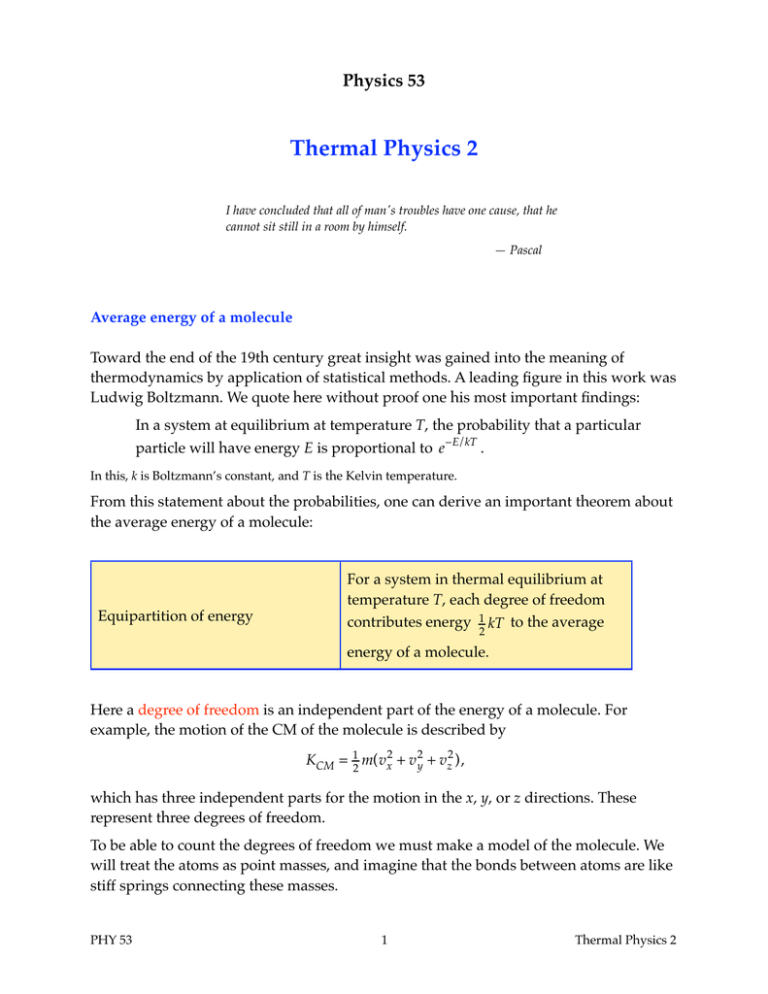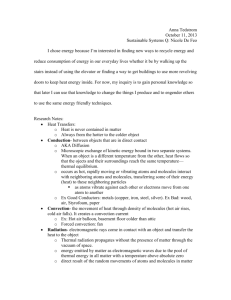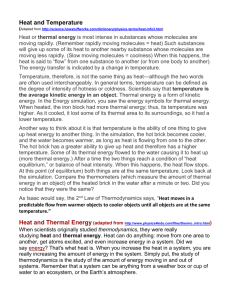Thermal Physics 2 Physics 53
advertisement

Physics 53 Thermal Physics 2 I have concluded that all of man's troubles have one cause, that he cannot sit still in a room by himself. — Pascal Average energy of a molecule Toward the end of the 19th century great insight was gained into the meaning of thermodynamics by application of statistical methods. A leading figure in this work was Ludwig Boltzmann. We quote here without proof one his most important findings: In a system at equilibrium at temperature T, the probability that a particular particle will have energy E is proportional to e −E/kT . In this, k is Boltzmann’s constant, and T is the Kelvin temperature. From this statement about the probabilities, one can derive an important theorem about the average energy of a molecule: Equipartition of energy For a system in thermal equilibrium at temperature T, each degree of freedom contributes energy 1 kT to the average 2 energy of a molecule. Here a degree of freedom is an independent part of the energy of a molecule. For example, the motion of the CM of the molecule is described by KCM = 12 m(vx2 + v y2 + vz2 ) , which has three independent parts for the motion in the x, y, or z directions. These represent three degrees of freedom. To be able to count the degrees of freedom we must make a model of the molecule. We will treat the atoms as point masses, and imagine that the bonds between atoms are like stiff springs connecting these masses. PHY 53 1 Thermal Physics 2 A monatomic gas (such as helium) will consist simply of point masses, each with three degrees of freedom from the three terms in KCM as above. A diatomic molecule will have four additional degrees of freedom besides these three: • The molecule can rotate about two independent axes passing through the CM and perpendicular to the line between the atoms. This gives two degrees of freedom. Rotation about the line between point-like atoms gives no degree of freedom because the moment of inertia about that axis is zero and hence there is no rotational energy. • The atoms can vibrate back and forth along the line between them. The kinetic energy of this vibration gives one degree of freedom. • The potential energy of the “spring” in this vibration gives another degree of freedom. Since it has three degrees of freedom, a monatomic gas molecule should, if equipartition of energy holds true, have average energy 32 kT , while a diatomic molecule which has seven degrees of freedom should have average energy 7 kT 2 . We will see later that these predictions can be tested by experimental measurements of specific heats. Thermal expansion The increase in average energy of the molecules with increasing temperature is responsible for many familiar phenomena in our everyday experience. One of these is the fact that most solid or liquid substances expand when heated. U r1 r2 r E2 E1 PHY 53 2 Thermal Physics 2 The reason for this lies in the detailed shape of the potential energy curve for the interaction of nearest neighbor particles. A typical curve is shown above. At small separations, when the molecules are close together, they experience a strong repulsion, represented by the rapidly rising potential energy curve. This repulsion arises largely from the effects of the Pauli exclusion principle which comes into play when the electron systems of the molecules begin to overlap significantly. For larger separations there is a weaker attractive electrical force, which is what holds the molecules close to each other in the solid or liquid phase. The minimum in the curve represents a distance at which the molecules could remain at rest in stable equilibrium if they had the lowest possible energy. For higher energies the molecules oscillate between their turning points (the distances at which the total energy line crosses the potential energy curve). Shown in the figure are two average energies, corresponding to different temperatures, where higher temperature goes with higher average energy. The points r1 and r2 represent the average separation — midway between the turning points — of the molecules for these two temperatures. Because the curve has shallower slope for larger r, the average separation increases as the energy (and temperature) is increased. Thus r2 is larger than r1 . On average the particles move farther apart as the temperature increases, which means that the object expands. This is the situation for most solids and liquids. There are substances for which the asymmetry in the curve is the other way (the slope is steeper to the right of the minimum) for some range of energies; this means the substance expands as the temperature falls. The most important such case is that of water near its freezing point, which expands as the temperature is lowered. This property makes ice float on water, which has been crucially important for the development of life on this planet. If the temperature differences are small, the fractional change in average separation will also be small, and one can write an approximate linear relation: ΔL = α ΔT L Thermal expansion Here L is a linear dimension of the object, ΔL is the change in that dimension as the temperature changed by ΔT, and α is (approximately) a constant called the coefficient of thermal expansion. For most liquids α is of order 10−4 (in SI units) while for most solids it is of order 10−5 . PHY 53 3 Thermal Physics 2 Failure of classical models We saw earlier that the equipartition of energy theorem predicts the average energy per molecule to be given by Eav = N f ⋅ 12 kT , where N f is the number of degrees of freedom. From this we can easily obtain a prediction about cV for a gas: cV = ( ) 1 dEint 1 d Nk = N ⋅ N f ⋅ 12 kT = 12 N f . n dT n dT n Using N = nN A and N A k = R we find the simple prediction cV = 12 n f ⋅ R . Note especially the general prediction that cV is completely independent of temperature. Let us look at some cases: • For a monatomic gas such as He, the only degrees of freedom are those of motion of the CM, which gives N f = 3 , and the prediction is cV = 32 R . • For a diatomic gas such as H 2 , there are 4 additional degrees of freedom: two modes of rotation about the CM plus kinetic and potential energy of vibration along the line between the atoms. The prediction is cV = 72 R . • For a crystalline solid such as Al, the atoms are constrained to vibrate about their equilibrium positions. Each of the three possible directions of this vibration give two degrees of freedom (kinetic and potential energy), so the prediction is cV = 3R . These predictions are unambiguous, and in all three cases say that cV should not change with temperature. The figure below shows the experimental data: PHY 53 4 Thermal Physics 2 cV/R 3.5 3.0 2.5 1.5 10 100 1000 10000 T Only the monatomic gas (He) agrees with the theoretical prediction for all temperatures. At “normal” temperatures (around 300 K and higher) the solid (Al) agrees with the prediction, as do most solids. This fact that most solids (diamond is an exception) at ordinary temperatures have specific heat 3R has been known since the early 19th century, and is called the Dulong-Petit law. But at low temperatures the specific heat of the solid drops and appears to be approaching zero. The diatomic gas ( H 2 ) has cV = 52 R at ordinary temperatures. At low temperatures it drops to the same value as for He. At very high temperatures (at which the molecule begins to dissociate) it seems to be approaching the predicted value of 72 R . This situation represents a dramatic failure of classical physics. The best clue as to where the problem lies is in the curve for H 2 . Why does the number of effective degrees of freedom change with temperature? The answer lies in quantum theory, where we learn that energy of both rotational and vibrational motion are “quantized”. This means that there is a specific and non-zero minimum amount of energy needed to make these kinds of motion occur at all. If this threshold energy is not available, the motion does not occur, and the corresponding degree of freedom disappears. We say it is “frozen”. We have seen that the average energy available for any degree of freedom is 1 kT . 2 If the temperature is very low this might not be enough to “thaw” a quantized degree of freedom. It usually takes less energy to start rotation than vibration, so the rotational degrees of freedom in H 2 are thawed first. By the time room temperature is reached PHY 53 5 Thermal Physics 2 they are active, but the vibrational ones are still frozen. That is why the effective value of N f is 5 at ordinary temperatures. Before the high temperature is reached at which vibrational degrees of freedom would be come active, collisions between molecules tend to dissociate them into their constituent atoms, and the measurements fail. In the case of Al, all the vibrations become frozen at very low temperatures, so all degrees of freedom tend to disappear and cV goes toward zero. For diamond, where the bonds are especially rigid, the “thawing” temperature for vibrations is well above room temperature, which is why diamond does not obey the Dulong-Petit law. Only for He, which has neither rotation nor vibration, does the classical theory work exactly. Thermal energy transfer We have discussed heat flow in terms of what it does to a system, but we have not examined how it happens. There are three main mechanisms by which thermal energy is transferred from one body to another: Conduction. The particles at the interface pass the energy along by collisions, the direction of net flow being from higher to lower temperature. Convection. Bulk quantities of a gas or liquid are transported from one location to another, carrying with them their thermal energy. This is a complicated fluid flow, usually involving considerable turbulence, so we do not treat it here. The most common mechanism for this flow is buoyant forces. Because warmer regions of the fluid are also less dense than the surrounding regions, the buoyant force pushes the warmer fluid upward, while cooler parts of the fluid correspondingly fall. Radiation. Thermal energy of a body is converted into electromagnetic radiation, which is emitted and subsequently absorbed by a second body, where it is reconverted into thermal energy. No details of the radiation are needed here except that it can travel through a vacuum. We will give here the basics of conduction and radiation. Conduction. In the situation shown, heat is flowing from an object at temperature T1 to one at lower temperature T2 . The heat flow is through a pipe of cross section area A. T1 PHY 53 T2 6 Thermal Physics 2 We are interested in the rate of flow of heat, dQ/dt . Let the change in temperature along the pipe be described by dT /dx , which is called the temperature gradient. Then the equation describing the flow through the pipe is dQ dT = −kA dt dx Heat conduction equation The constant k — which is not Boltzmann’s constant — is a property of the material in the pipe, called thermal conductivity. In this formula one must distinguish between time, t, and temperature, T. As the negative sign in the formula shows, for heat to flow in the positive x-direction, the temperature must fall in that direction, i.e., dT/dx must be negative. In other words, heat flows from higher to lower temperatures only. Radiation. Atoms and molecules emit and absorb energy in the form of electromagnetic radiation. Some of the radiation by particles on the surface of an object escapes and takes energy away from the system, sending it out into space. Particles on the surface also absorb radiation emitted elsewhere. In a system of macroscopic size at thermal equilibrium, radiation energy exchange can be an important factor. The rate at which radiation is emitted depends on the temperature, as does the distribution of the radiated frequencies, which gives heated objects their characteristic colors. It was discovered around 1800 that all solid objects at the same temperature glow with the same frequency spectrum. Attempts to explain details of this spectrum by classical physics failed utterly, and this problem led to the first introduction of the “quantum” idea by Planck in 1900. But analysis of the total rate of radiation at all frequencies requires only the laws of thermodynamics. The formula for the total rate of radiation at all frequencies was found experimentally in the late 19th century by Stefan, and accounted for theoretically by Boltzmann. I = eσ T 4 Stefan-Boltzmann law Here I is the power radiated per unit area of surface, T is the (Kelvin) temperature, σ is a universal constant called Stefan's constant, and e is a dimensionless number between 0 and 1 called the emissivity. In SI units σ = 5.67 × 10−8 . Absorption is governed by exactly the same law, where I represents the power absorbed per unit area of surface. PHY 53 7 Thermal Physics 2 A good emitter (e nearly 1) is also a good absorber. Highly reflective surfaces have low values of e, while the perfect absorber (and emitter), for which e = 1, is called a “blackbody”. A small hole in a hollow object, where radiation can go in but nearly all of it is absorbed, is a good approximation to a blackbody. When two bodies A and B at different temperatures TA and TB exchange energy by radiation, the net power emitted per unit area by A is I A = e Aσ (TA4 − TB4 ) . This formula is useful in explaining many everyday situations involving heat exchange by radiation. PHY 53 8 Thermal Physics 2






